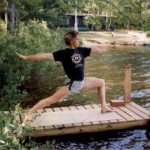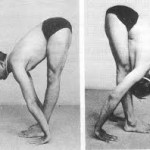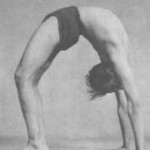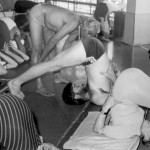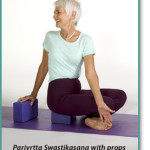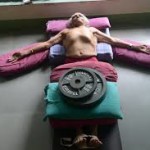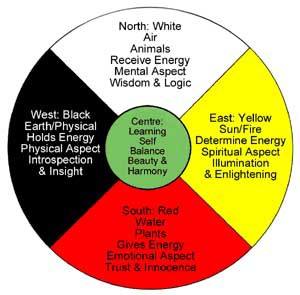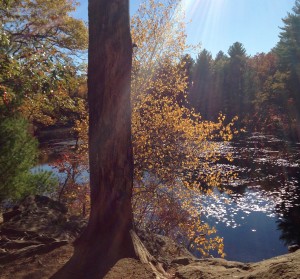Inhabiting a Multidimensional Universe
The recurring theme of the week was the embodied exploration of the seven sacred directions, using asana and movement, to: 1. expand the world we inhabit: 2. discover shadows, ie, the unconscious or unresolved areas of our psychic, as well as physical and physiological space: 3. bring our expanding awareness into the world around us, integrating with Nature, and our relationships: 4: discover the Soul and its primary urges for us in this lifetime. Remember the seven directions begin with the Heart center and include three pairs of complementary directions/energies. Our goal is to integrate these within the pair, and within the whole. Capitalization indicates referral to a sacred direction.
The Seven Sacred Directions
One: The Heart: Discover, feel and open your heart. The heart is the center, the intersection point of all the other directions. Let your personal heart expand into and merge with the Cosmic Heart and rest in the infinite stillness revealed there. Your heart knows how to do this. Your mind probably does not. This is our ‘natural state’, the ‘drashtuh svarupe” of the Yoga Sutras. This practice is 24/7/365.
Two: Earth: Find gravity and what we call down. We are in a body, on Mother Earth. When sitting or standing, feel the vertical line passing through your heart, through your core, down into Mother Earth and feel you heart merging with the heart of the Divine Mother. Feel your whole body responding to weight and grounding. Release and awaken your first or root chakra. Imagine the core line, or chakra line, open so all chakras connect through the root chakra into ground. Feel the stability, what Patanjali calls ‘sthira’. You cannot fall off the planet. You will not float away!
This direction also represents the underworld, the collective energetic experience of the whole 4.5 billion year old history of Mother Earth, the “Sacred Feminine”, with powers, information and support available to us through soul work, dream and shamanic studies. The western world long ago equated the underworld with hell, so it has become a collective region of pathology, fear and terror. We, as individuals, cultures and the planet as a whole, need to spend a lot of time in serious healing here. Step three will be necessary for this.
Three: Heaven: Find levity and lightness as you orient to up, to the sky. From the earth and heart, open your crown chakra and extend the core chakra line  upward into the heavens. Feel the levity or lightness in your cells and bones, the expanding upwards of your energy without losing ground. Feel the weight and lightness in balance from the heart as you sit or stand ‘suspended’ or floating between heaven and earth. All chakras turned on and glowing gently, quietly. Feel your chakra line like the center axis of a gyroscope, stabilizing. The heavenly realms are also so home of the angels, devas, Buddhas and other teachers of ascendent and transcendent wisdom. Lots of support for our soul and social journey resides here. Integration of Heaven and Earth gives us our vertical axis, the core of the fundamental ‘posture’ of the human, and completes the first stage in preparation for asana or any embodied exploration.
upward into the heavens. Feel the levity or lightness in your cells and bones, the expanding upwards of your energy without losing ground. Feel the weight and lightness in balance from the heart as you sit or stand ‘suspended’ or floating between heaven and earth. All chakras turned on and glowing gently, quietly. Feel your chakra line like the center axis of a gyroscope, stabilizing. The heavenly realms are also so home of the angels, devas, Buddhas and other teachers of ascendent and transcendent wisdom. Lots of support for our soul and social journey resides here. Integration of Heaven and Earth gives us our vertical axis, the core of the fundamental ‘posture’ of the human, and completes the first stage in preparation for asana or any embodied exploration.
 Four: East or Front: Discover your front body. Face the east, and all subsequent directions will assume this as our base position. Obviously, we will equate the east direction with the front body, as Iyengar demonstrates in ‘purvottanasana’, the intense stretch to the east (side of the body) pose. Notice your eyes naturally face forward from the front and therefore we tend to be much more conscious of the front body, as we can see it best. From an embryological perspective, the front represents the gut body or endoderm, including throat, lungs, intestines, liver and stomach and bladder. It is soft and vulnerable. From the perspective of our psychic body, the east represents sunrise in the daily cycle and the season of springtime. We find new beginnings and the joy and innocence of
Four: East or Front: Discover your front body. Face the east, and all subsequent directions will assume this as our base position. Obviously, we will equate the east direction with the front body, as Iyengar demonstrates in ‘purvottanasana’, the intense stretch to the east (side of the body) pose. Notice your eyes naturally face forward from the front and therefore we tend to be much more conscious of the front body, as we can see it best. From an embryological perspective, the front represents the gut body or endoderm, including throat, lungs, intestines, liver and stomach and bladder. It is soft and vulnerable. From the perspective of our psychic body, the east represents sunrise in the daily cycle and the season of springtime. We find new beginnings and the joy and innocence of 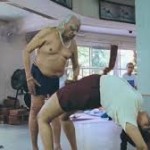 youth, with lightheartedness combined with a subtle wisdom that is simultaneously both very old and very new. It is not wisdom of culture or education, but of the heart. The front also represents the future and our future selves yet to be revealed. In asana, the front body is opened and explored in depth through the element fire in back-bending poses, either supported or dynamic.
youth, with lightheartedness combined with a subtle wisdom that is simultaneously both very old and very new. It is not wisdom of culture or education, but of the heart. The front also represents the future and our future selves yet to be revealed. In asana, the front body is opened and explored in depth through the element fire in back-bending poses, either supported or dynamic.
Five: West or Back: The complementary direction to the front is the  back, the west side of the body as shown in ‘paschimottanasana‘, the intense stretch of the west side. West is where the sun sets, so the west represents endings and letting go. The season is fall. In contrast to the East, he Western psychic space is weighty and dark, and is the direction through which we discover the underground and the soul. The back body, as West, represents the past, in its collective wisdom, but also in the karma of our unconscious, unresolved issues, from this lifetime, and previous ones. Thomas Hübl calls this our ‘backpack’ of burdens we carry around in life. As we ’empty’ this backpack though therapy, soul work and inner reflection, we free up energy for our future selves and make the present moment much lighter. In asana, forward bending poses lengthen, soften and relax the back body. In embryology, the back body is the endoderm or nervous system which is soothed, softened and opened in asana practice, by the element water and forward bending postures.
back, the west side of the body as shown in ‘paschimottanasana‘, the intense stretch of the west side. West is where the sun sets, so the west represents endings and letting go. The season is fall. In contrast to the East, he Western psychic space is weighty and dark, and is the direction through which we discover the underground and the soul. The back body, as West, represents the past, in its collective wisdom, but also in the karma of our unconscious, unresolved issues, from this lifetime, and previous ones. Thomas Hübl calls this our ‘backpack’ of burdens we carry around in life. As we ’empty’ this backpack though therapy, soul work and inner reflection, we free up energy for our future selves and make the present moment much lighter. In asana, forward bending poses lengthen, soften and relax the back body. In embryology, the back body is the endoderm or nervous system which is soothed, softened and opened in asana practice, by the element water and forward bending postures.
The pose of balance between the front and back bodies is of course tadasana, or sirsanasa. The tissue layer of balance is the mesoderm, or middle layer. In kinesiology, mammalian flexion and extension involve waves traveling back and forth between front and back bodies, so healthy movements are integrating. We will come back to this very important layer a little bit later in this article. This completes stage two.
Six: South or Right: As we face east, the right side of the body points to the south. The right is the solar, yang or masculine side of the yoga energy channels. The south, halfway between east and west, represents noon or mid-day, when  the light is the brightest and youthful energy is at its peak. It’s energy is wild, liberated and exuberant. The season is summer. The psychic space is full of eros, the celebration of aliveness and the fullness of Nature’s bounty.
the light is the brightest and youthful energy is at its peak. It’s energy is wild, liberated and exuberant. The season is summer. The psychic space is full of eros, the celebration of aliveness and the fullness of Nature’s bounty.
Seven: North or Left: The left side correspondingly faces the north, the season of winter, the time of day,  midnight. The lunar nadi is the left, the feminine, yin or cooling side. The psychic sphere is the realm of the wise elders, guides, teachers and parents. This balances the youthful enthusiasm of the south. Without the north, the wildness of the south energy can get out of hand and become destructive. Without the youthful south to balance, the old age of the north can become cold, dry and fossilized. All pairs balance each other, and to integrate is to realize how to bring the pairs together as wholeness.
midnight. The lunar nadi is the left, the feminine, yin or cooling side. The psychic sphere is the realm of the wise elders, guides, teachers and parents. This balances the youthful enthusiasm of the south. Without the north, the wildness of the south energy can get out of hand and become destructive. Without the youthful south to balance, the old age of the north can become cold, dry and fossilized. All pairs balance each other, and to integrate is to realize how to bring the pairs together as wholeness.
In Embryology, right and left emerge out of the middle layer, the mesoderm where a single energy channel becomes seven, three right, three left, and the center, giving birth to the spinal vertebrae, heart, kidneys and limbs, as well as other connective tissue structures. We explore this median plane and its relationship to right and left in the lateral standing poses such as trikonasana, parsvakonasana and half moon, as well as anantasana and variations. Right and left complete stage three, and we now have our seven sacred directions, the heart as center, and three pairs of complementary energy fields that, when working together, give us a fully embodied, three dimensional field of perception, action and intelligence, from cell to skin ans skin to cell. This is of course, samyama in asana.
Explorations:
Step Eight: As we are in the Caribbean, with the amazing reefs of St. John all around us, we can take this 7 directional field of intelligence into the water, especially snorkeling or scuba diving. When swimming, notice our chakra line is no longer oriented to heaven and earth, but parallel to the earth, along our N-E-S-W compass lines. The front body face down to the earth, back body the heavens. This is a very different orientation, and a very rich one for humans to explore. Also, the buoyancy of the water takes much of the effort out of the muscles, so we can literally float in the water. This too is a hugely fertile field of sensations and movement explorations play with. Rather than just the mechanics of swimming, play with the buoyancy changes the energy fields of the seven directions.
 Step Nine: Now, moving your intelligence field and your mirror neuronal sytem out into the water, begin to embody, or imagine what it feels like to be a: sting ray: turtle: reef fish like a tang: a parrotfish; a sea anemone or sea fan, etc. What do you ‘feel’ when you allow the energy of your chosen being to fill your inner world? What new shapes in your field can you give birth to ?
Step Nine: Now, moving your intelligence field and your mirror neuronal sytem out into the water, begin to embody, or imagine what it feels like to be a: sting ray: turtle: reef fish like a tang: a parrotfish; a sea anemone or sea fan, etc. What do you ‘feel’ when you allow the energy of your chosen being to fill your inner world? What new shapes in your field can you give birth to ?
 Step Ten: Afternnoon breathing sessions: Our omni-directional intelligence also expands and condenses radially, like the movements of the hoberman spheres, and this offers us another pair of energies to explore and integrate. (tato dvandva anabhigatah, PYS II-48). We can also relate these movements to the Prana vayus, the yogic model of physiological activity.
Step Ten: Afternnoon breathing sessions: Our omni-directional intelligence also expands and condenses radially, like the movements of the hoberman spheres, and this offers us another pair of energies to explore and integrate. (tato dvandva anabhigatah, PYS II-48). We can also relate these movements to the Prana vayus, the yogic model of physiological activity.
The prana vayu governs what we take in. It is the expanding, centrifugal energy of getting larger as we fill up. The prana vayu is centered in the chest to help draw breath into the lungs as inhalation, and blood back to the heart. So we want the chest cavity to really feel its expandability, its capacity to open and increase its volume. However, this is not accomplished by using the spinal muscles, or contracting in any way. Inhalation requires getting out of the way and allowing the natural opening to emerge. When possible, use a bolster or rolled up blanket to lift the chest slightly.
The apana vayu governs what we let go of, what we eliminate, and involves a squeezing or condensing centered in the belly and pelvic areas. We take in one direction, through the mouth and nostrils and down into lungs and stomach. But we squeeze out in two directions, down for solid and liquid wastes, but up for exhaling the breath. So the energy of the apana has to be very intelligent and alert to make sure both directions are operating as desired.
The Practice:
Part 1: either seated or lying down, keep the spine long and relaxed. On the inhalation, without any force or tension, invite the in breath to be primarily driven by the sideways expansion of the ribs, allowing the inter-costal muscles to open. On the exhalation, with minimal tension, allow the exhalation to come from the squeezing of the abdominal wall and not a dropping of the chest. This will help stretch out the diaphragm. Later, we will integrate the ribs with the exhalation, but not before the diaphragm has really opened up. Continue to breathe this way, gradually expanding the chest wall, lifting and opening the dome of the diaphragm, and strengthening the abdominal wall. Notice the squeezing of this is from the back and sides to the center and not a shortening like in a sit-up.
Part 2: Morning Asana: In tadasana find your navel. Imagine your original navel as a portal entering from the front and flowing back towards the spine. As the energy draws your navel to the spine, feel the back of the mesentery, behind the intestines, widening and spreading right and left. Next, imagine or feel this spreading tissue, when it reaches the outer sides of the body, begin to wrap around toward the front. Now let the two ends meet in the middle front body and knit together. Back, Widen, Wrap and Knit. This tones the core, like a mild 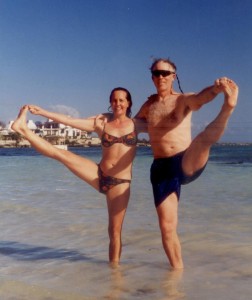 uddiyana bandha. Feel it down inside the pelvis, and up under the ribs around and below the diaphragm. Keep this toned as you breathe in and out. Exhalation will increase the tone. Try not to collapse the tone on the in-breath. Connect this feeling to your legs as well.
uddiyana bandha. Feel it down inside the pelvis, and up under the ribs around and below the diaphragm. Keep this toned as you breathe in and out. Exhalation will increase the tone. Try not to collapse the tone on the in-breath. Connect this feeling to your legs as well.
Explore what happens to this tone when you go from tadasana into uttanasana and back. Same in any of the standing poses.




